Matan Levy
Story2Board: A Training-Free Approach for Expressive Storyboard Generation
Aug 13, 2025Abstract:We present Story2Board, a training-free framework for expressive storyboard generation from natural language. Existing methods narrowly focus on subject identity, overlooking key aspects of visual storytelling such as spatial composition, background evolution, and narrative pacing. To address this, we introduce a lightweight consistency framework composed of two components: Latent Panel Anchoring, which preserves a shared character reference across panels, and Reciprocal Attention Value Mixing, which softly blends visual features between token pairs with strong reciprocal attention. Together, these mechanisms enhance coherence without architectural changes or fine-tuning, enabling state-of-the-art diffusion models to generate visually diverse yet consistent storyboards. To structure generation, we use an off-the-shelf language model to convert free-form stories into grounded panel-level prompts. To evaluate, we propose the Rich Storyboard Benchmark, a suite of open-domain narratives designed to assess layout diversity and background-grounded storytelling, in addition to consistency. We also introduce a new Scene Diversity metric that quantifies spatial and pose variation across storyboards. Our qualitative and quantitative results, as well as a user study, show that Story2Board produces more dynamic, coherent, and narratively engaging storyboards than existing baselines.
Find your Needle: Small Object Image Retrieval via Multi-Object Attention Optimization
Mar 10, 2025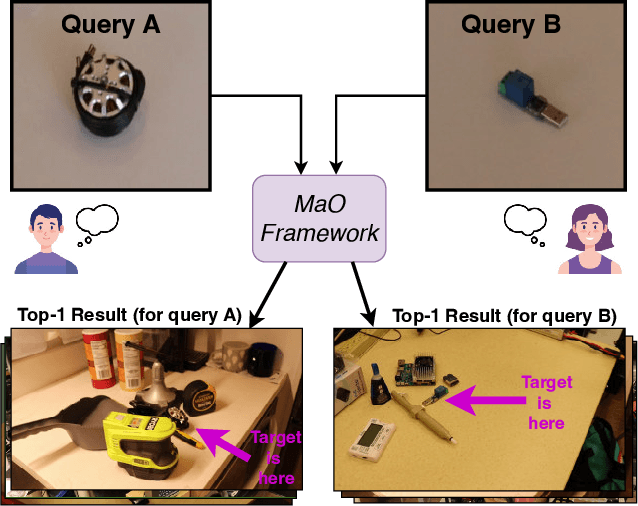
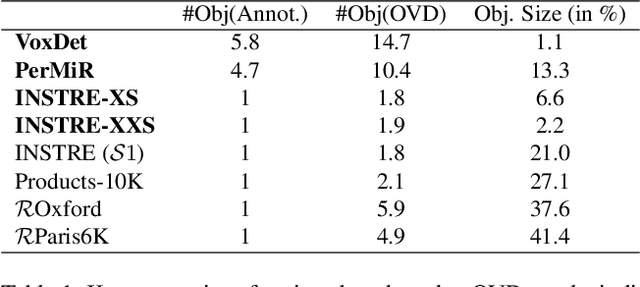
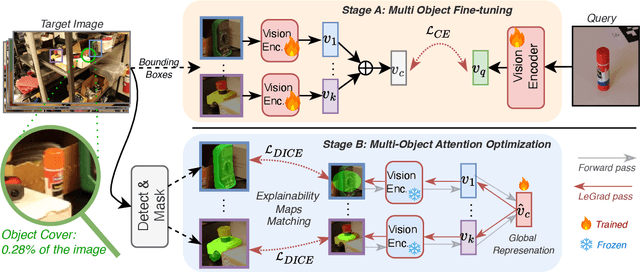
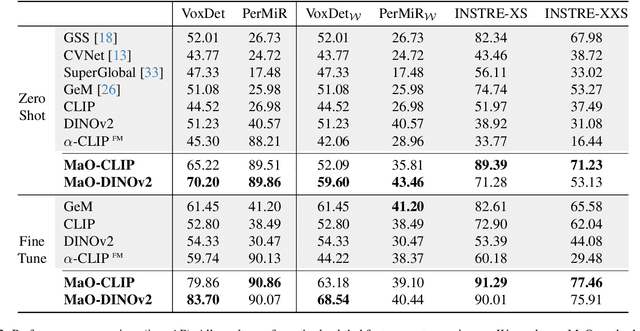
Abstract:We address the challenge of Small Object Image Retrieval (SoIR), where the goal is to retrieve images containing a specific small object, in a cluttered scene. The key challenge in this setting is constructing a single image descriptor, for scalable and efficient search, that effectively represents all objects in the image. In this paper, we first analyze the limitations of existing methods on this challenging task and then introduce new benchmarks to support SoIR evaluation. Next, we introduce Multi-object Attention Optimization (MaO), a novel retrieval framework which incorporates a dedicated multi-object pre-training phase. This is followed by a refinement process that leverages attention-based feature extraction with object masks, integrating them into a single unified image descriptor. Our MaO approach significantly outperforms existing retrieval methods and strong baselines, achieving notable improvements in both zero-shot and lightweight multi-object fine-tuning. We hope this work will lay the groundwork and inspire further research to enhance retrieval performance for this highly practical task.
Task-Specific Adaptation with Restricted Model Access
Feb 02, 2025

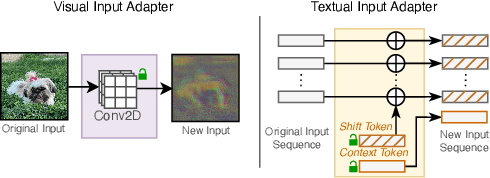
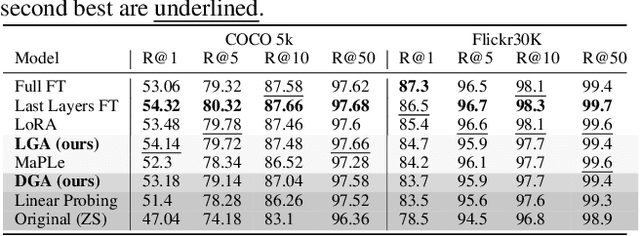
Abstract:The emergence of foundational models has greatly improved performance across various downstream tasks, with fine-tuning often yielding even better results. However, existing fine-tuning approaches typically require access to model weights and layers, leading to challenges such as managing multiple model copies or inference pipelines, inefficiencies in edge device optimization, and concerns over proprietary rights, privacy, and exposure to unsafe model variants. In this paper, we address these challenges by exploring "Gray-box" fine-tuning approaches, where the model's architecture and weights remain hidden, allowing only gradient propagation. We introduce a novel yet simple and effective framework that adapts to new tasks using two lightweight learnable modules at the model's input and output. Additionally, we present a less restrictive variant that offers more entry points into the model, balancing performance with model exposure. We evaluate our approaches across several backbones on benchmarks such as text-image alignment, text-video alignment, and sketch-image alignment. Results show that our Gray-box approaches are competitive with full-access fine-tuning methods, despite having limited access to the model.
Impactful Bit-Flip Search on Full-precision Models
Nov 12, 2024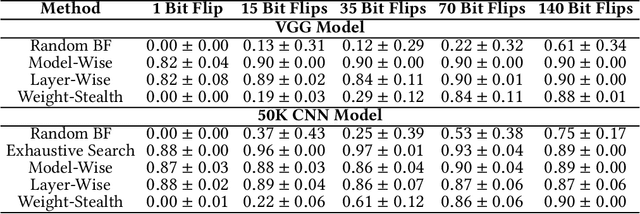
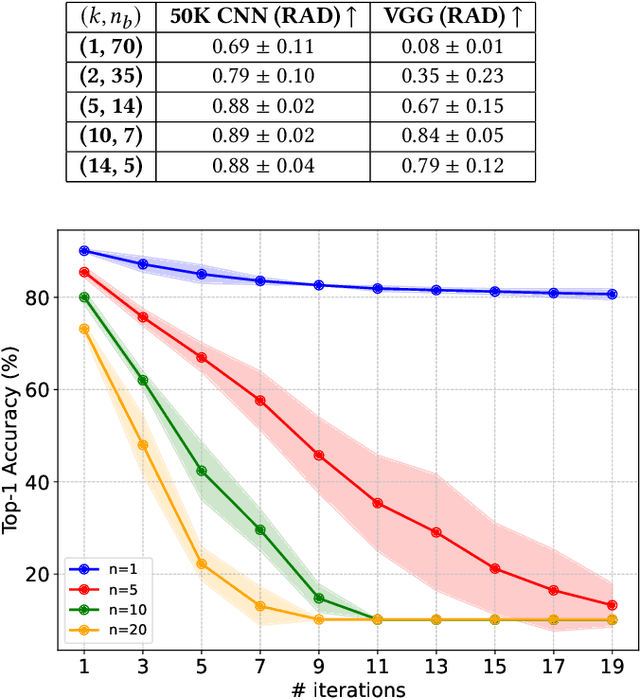
Abstract:Neural networks have shown remarkable performance in various tasks, yet they remain susceptible to subtle changes in their input or model parameters. One particularly impactful vulnerability arises through the Bit-Flip Attack (BFA), where flipping a small number of critical bits in a model's parameters can severely degrade its performance. A common technique for inducing bit flips in DRAM is the Row-Hammer attack, which exploits frequent uncached memory accesses to alter data. Identifying susceptible bits can be achieved through exhaustive search or progressive layer-by-layer analysis, especially in quantized networks. In this work, we introduce Impactful Bit-Flip Search (IBS), a novel method for efficiently pinpointing and flipping critical bits in full-precision networks. Additionally, we propose a Weight-Stealth technique that strategically modifies the model's parameters in a way that maintains the float values within the original distribution, thereby bypassing simple range checks often used in tamper detection.
Accelerating Error Correction Code Transformers
Oct 08, 2024Abstract:Error correction codes (ECC) are crucial for ensuring reliable information transmission in communication systems. Choukroun & Wolf (2022b) recently introduced the Error Correction Code Transformer (ECCT), which has demonstrated promising performance across various transmission channels and families of codes. However, its high computational and memory demands limit its practical applications compared to traditional decoding algorithms. Achieving effective quantization of the ECCT presents significant challenges due to its inherently small architecture, since existing, very low-precision quantization techniques often lead to performance degradation in compact neural networks. In this paper, we introduce a novel acceleration method for transformer-based decoders. We first propose a ternary weight quantization method specifically designed for the ECCT, inducing a decoder with multiplication-free linear layers. We present an optimized self-attention mechanism to reduce computational complexity via codeaware multi-heads processing. Finally, we provide positional encoding via the Tanner graph eigendecomposition, enabling a richer representation of the graph connectivity. The approach not only matches or surpasses ECCT's performance but also significantly reduces energy consumption, memory footprint, and computational complexity. Our method brings transformer-based error correction closer to practical implementation in resource-constrained environments, achieving a 90% compression ratio and reducing arithmetic operation energy consumption by at least 224 times on modern hardware.
EffoVPR: Effective Foundation Model Utilization for Visual Place Recognition
May 28, 2024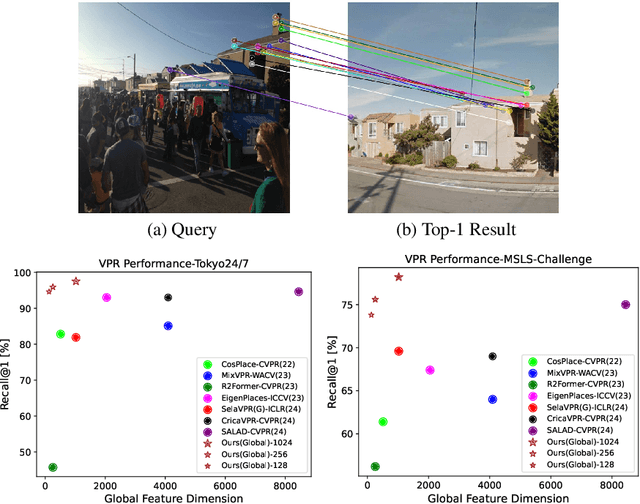
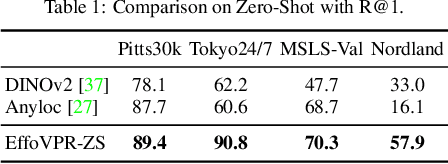
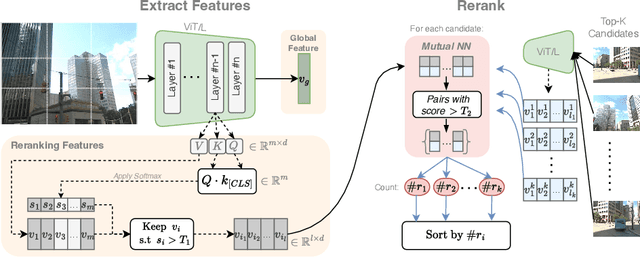
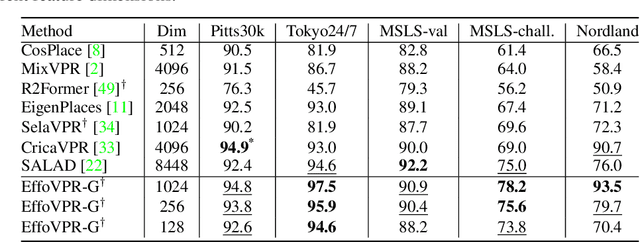
Abstract:The task of Visual Place Recognition (VPR) is to predict the location of a query image from a database of geo-tagged images. Recent studies in VPR have highlighted the significant advantage of employing pre-trained foundation models like DINOv2 for the VPR task. However, these models are often deemed inadequate for VPR without further fine-tuning on task-specific data. In this paper, we propose a simple yet powerful approach to better exploit the potential of a foundation model for VPR. We first demonstrate that features extracted from self-attention layers can serve as a powerful re-ranker for VPR. Utilizing these features in a zero-shot manner, our method surpasses previous zero-shot methods and achieves competitive results compared to supervised methods across multiple datasets. Subsequently, we demonstrate that a single-stage method leveraging internal ViT layers for pooling can generate global features that achieve state-of-the-art results, even when reduced to a dimensionality as low as 128D. Nevertheless, incorporating our local foundation features for re-ranking, expands this gap. Our approach further demonstrates remarkable robustness and generalization, achieving state-of-the-art results, with a significant gap, in challenging scenarios, involving occlusion, day-night variations, and seasonal changes.
Unveiling the Power of Diffusion Features For Personalized Segmentation and Retrieval
May 28, 2024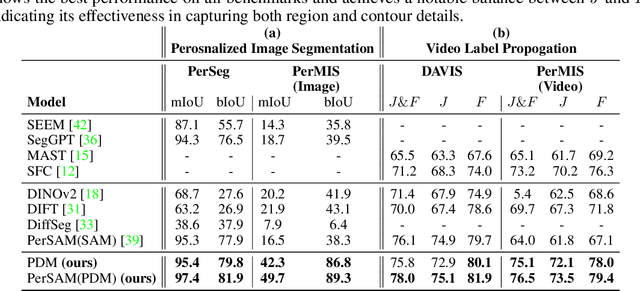

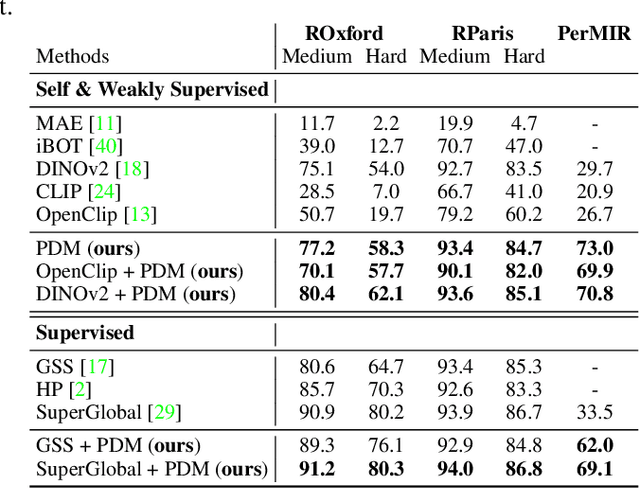
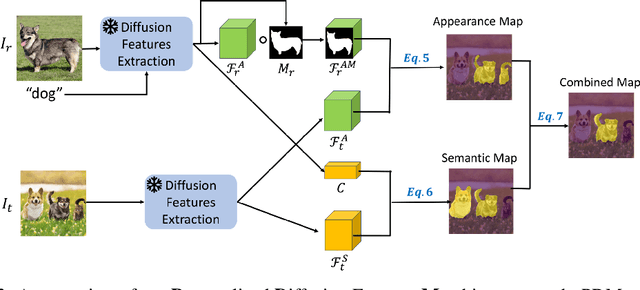
Abstract:Personalized retrieval and segmentation aim to locate specific instances within a dataset based on an input image and a short description of the reference instance. While supervised methods are effective, they require extensive labeled data for training. Recently, self-supervised foundation models have been introduced to these tasks showing comparable results to supervised methods. However, a significant flaw in these models is evident: they struggle to locate a desired instance when other instances within the same class are presented. In this paper, we explore text-to-image diffusion models for these tasks. Specifically, we propose a novel approach called PDM for Personalized Features Diffusion Matching, that leverages intermediate features of pre-trained text-to-image models for personalization tasks without any additional training. PDM demonstrates superior performance on popular retrieval and segmentation benchmarks, outperforming even supervised methods. We also highlight notable shortcomings in current instance and segmentation datasets and propose new benchmarks for these tasks.
Chatting Makes Perfect -- Chat-based Image Retrieval
May 31, 2023Abstract:Chats emerge as an effective user-friendly approach for information retrieval, and are successfully employed in many domains, such as customer service, healthcare, and finance. However, existing image retrieval approaches typically address the case of a single query-to-image round, and the use of chats for image retrieval has been mostly overlooked. In this work, we introduce ChatIR: a chat-based image retrieval system that engages in a conversation with the user to elicit information, in addition to an initial query, in order to clarify the user's search intent. Motivated by the capabilities of today's foundation models, we leverage Large Language Models to generate follow-up questions to an initial image description. These questions form a dialog with the user in order to retrieve the desired image from a large corpus. In this study, we explore the capabilities of such a system tested on a large dataset and reveal that engaging in a dialog yields significant gains in image retrieval. We start by building an evaluation pipeline from an existing manually generated dataset and explore different modules and training strategies for ChatIR. Our comparison includes strong baselines derived from related applications trained with Reinforcement Learning. Our system is capable of retrieving the target image from a pool of 50K images with over 78% success rate after 5 dialogue rounds, compared to 75% when questions are asked by humans, and 64% for a single shot text-to-image retrieval. Extensive evaluations reveal the strong capabilities and examine the limitations of CharIR under different settings.
Data Roaming and Early Fusion for Composed Image Retrieval
Mar 16, 2023Abstract:We study the task of Composed Image Retrieval (CoIR), where a query is composed of two modalities, image and text, extending the user's expression ability. Previous methods typically address this task by a separate encoding of each query modality, followed by late fusion of the extracted features. In this paper, we propose a new approach, Cross-Attention driven Shift Encoder (CASE), employing early fusion between modalities through a cross-attention module with an additional auxiliary task. We show that our method outperforms the existing state-of-the-art, on established benchmarks (FashionIQ and CIRR) by a large margin. However, CoIR datasets are a few orders of magnitude smaller compared to other vision and language (V&L) datasets, and some suffer from serious flaws (e.g., queries with a redundant modality). We address these shortcomings by introducing Large Scale Composed Image Retrieval (LaSCo), a new CoIR dataset x10 times larger than current ones. Pre-training on LaSCo yields a further performance boost. We further suggest a new analysis of CoIR datasets and methods, for detecting modality redundancy or necessity, in queries.
Classification-Regression for Chart Comprehension
Nov 29, 2021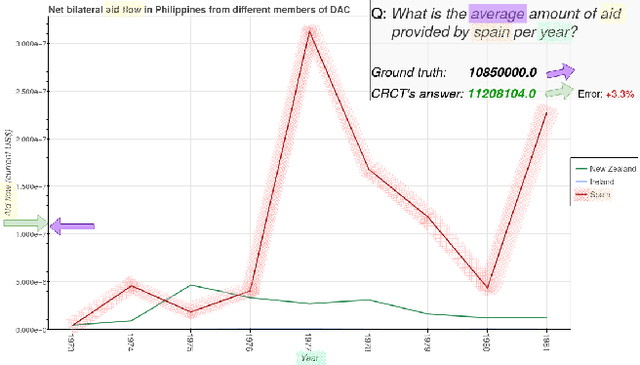

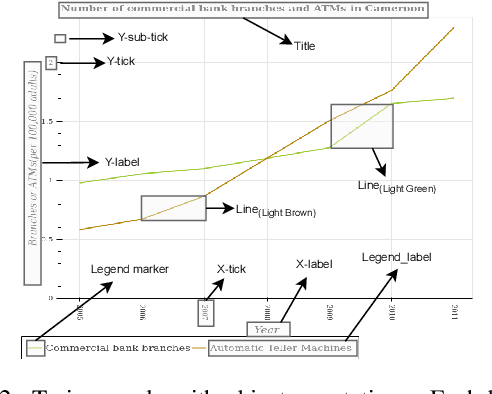
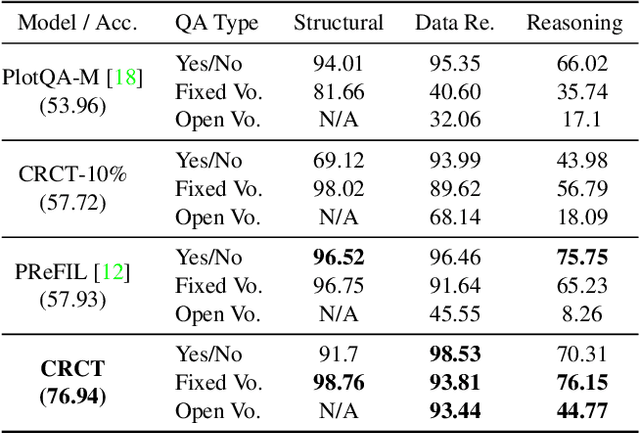
Abstract:Charts are a popular and effective form of data visualization. Chart question answering (CQA) is a task used for assessing chart comprehension, which is fundamentally different from understanding natural images. CQA requires analyzing the relationships between the textual and the visual components of a chart, in order to answer general questions or infer numerical values. Most existing CQA datasets and it models are based on simplifying assumptions that often enable surpassing human performance. In this work, we further explore the reasons behind this outcome and propose a new model that jointly learns classification and regression. Our language-vision set up with co-attention transformers captures the complex interactions between the question and the textual elements, which commonly exist in real-world charts. We validate these conclusions with extensive experiments and breakdowns on the realistic PlotQA dataset, outperforming previous approaches by a large margin, while showing competitive performance on FigureQA. Our model's edge is particularly emphasized on questions with out-of-vocabulary answers, many of which require regression. We hope that this work will stimulate further research towards solving the challenging and highly practical task of chart comprehension.
 Add to Chrome
Add to Chrome Add to Firefox
Add to Firefox Add to Edge
Add to Edge